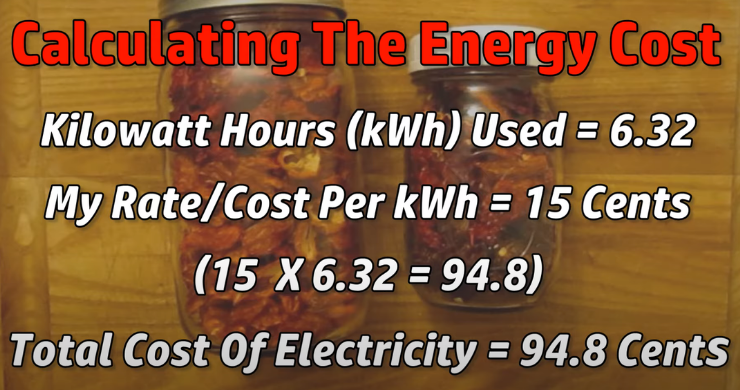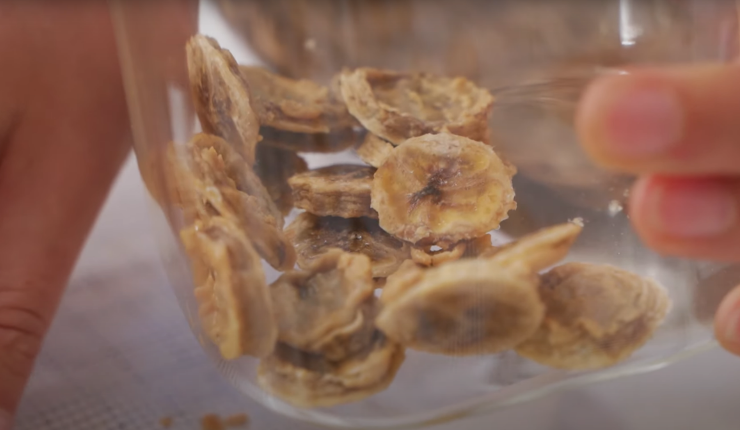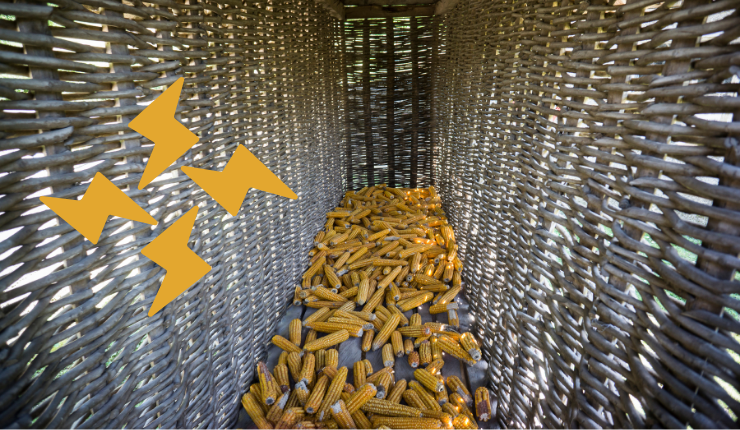A dehydrator is a food air-dryer useful for making tasty dried food like beef jerky and dried fruits. My favorites are dried apples and apricots.
I do love this air-dryer! pic.twitter.com/KYACZHjLfG
— Mike’l Severe (@MikelSevere) August 15, 2019
After reading this article, you will know:
- How much electricity does a food dehydrator use?
- How a food air-dryer works.
- Some tasty things you can make.
- How to dehydrate foods without a food air-dryer.
Ready to get on with the fun? If you have kids be sure to get them to help.
Contents
- 1. How Much Electricity Does a Food Air-dryer Use? →
- 2. Does the Food Air-Dryer Use a Lot Of Electricity? →
- 3. How Does a Food Air-dryer Work? →
- 4. Uses For a Food Air-Dryer →
- 5. Energy-Efficient Food Dehydrator →
- 6. How to Dehydrate Food Without Electricity →
- 7. Tasty Recipes →
- 7.1. Recipe for Orange Creamsicle Fruit Leather →
- 7.2. Recipe for Peanut Butter Banana Chips →
- 8. Useful Resources →
The Ins And Outs of Food Dehydrators
It is easy to dehydrate foods, and the results are super delicious. All you need to do is prepare the food in thin slices, place it on trays, and then, after a bit of patience to let the magic happen (four to six hours on average), you will have a tasty treat.
How Much Electricity Does a Food Dehydrator Use?
Every food air-dryer will use a different amount of electricity so check with the manufacturer’s specifications. Most large dehydrators use about one kWh per hour or less.
This video by Enphase Energy explains how to understand a kilowatt-hour.
The abbreviation for kilowatt-hour is kWh.
While we are on the subject of power consumption, I am reminded about the question I was asked regarding using paper plates in a microwave here.
Does the Food Air-Dryer Use a Lot Of Electricity?
A food air-dryer may use a lot of electricity if it runs all the time. While the food air-dryer may only use one kW or less per hour, continuous use means it would run about 740 hours per month. On the other hand, it is much cheaper than using the stove.
To figure out how much your electricity bill will be, get the manufacturer’s specifications for your food air-dryer of electricity usage when operating in kilowatts. Then, estimate the number of hours you will run it. Then multiply this energy consumption by the rate you pay for the electricity you find on an electrical bill.

Be careful to note if you pay higher rates for more usage or usage at different times of day to adjust your calculations accordingly.
Electricity rates in the USA, range from about 4 cents to 20 cents per kWh. For example, if your food air-dryer uses one kilowatt (kW) per hour for six hours, that would equal six kilowatt-hours (kWh).
In California, the average electricity cost is high at 20 cents per kWh, so that would be a cost of $1.20 to run a food dehydrator for six hours. In a place with cheaper power, 4 cents per kWh, this would only cost 24 cents.
In this video by The Purposeful Pantry, you can understand more about what it costs to run your food dehydrator.
It can be very cheap to run a food air-dryer depending on where you live.
How Does a Food Dehydrator Work?
A food air-dryer works to dry out food by circulating warm air hot enough to dry out the food but not cook it. Make thin slices of the food you want to dehydrate and place the slices on the drying racks with some space between the pieces.
Here are the recommendations from Good Housekeeping regarding the temperatures to use for different foods:
- Herbs: Use a temperature of 95°F (35°C). Herbs are delicate, so they need to be dried using very low heat. This temperature will prevent them from drying too much and changing color.
- Vegetables: Use a temperature of 125°F (52°C) for vegetables that have more thickness and water content than herbs, such as zucchini, kale, yams, etc.
- Fruits: Use a temperature of 135°F (57°C) to dry out fruits with lots of water content such as slices of apples, apricots, bananas, peaches, strawberries, and tomatoes. Did you know that a tomato is a fruit?
- Meats: Cook the meat first until it reaches an internal temperature of 165°F (74°C), which you verify using a meat thermometer. This method helps ensure that the cooking process kills any bacteria in the meat at a high enough temperature. Then, for dehydrating the meat, use a temperature of 130°F to 140°F (54°C to 60°C).
Be careful with meats and, if they are frozen, thaw them before cooking. For example, learn about the dangers of deep-frying frozen chicken wings here.
If you are new to food dehydration, these Purposeful Pantry tips may help.
Pay close attention to the things that you should not try to dehydrate.
Uses For a Food Dehydrator
Besides making tasty snacks of slices of dried fruits, fruit leather, and beef jerky strips, you can also use a food air-dryer to dry out homemade pasta that you make with your pasta-making machine.
Bit of jerky in the dehydrator. And some steaks on the cast iron pan. Happy days. #freshbeef @barrelracernt pic.twitter.com/TWqa9JleOc
— BoutaNT (@bouta_nt) February 26, 2022
Another use is that I like to cut flowers from my garden at the peak of their most wonderful aroma. Then, I dry them in the food air-dryer to make sachets filled with delightful potpourri. I like to put the sachets in my clothes’ drawers and hang them in the closet. They give off a wonderful smell that the fabric of my clothes absorbs.
Another interesting tip is that you can re-crisp cookies or crackers that have gone stale from absorbing moisture. The slow, low heat in a food air-dryer is perfect for fermenting homemade yogurt.
If you have children, a fun project to do that only uses water and flour is to make a paste of the flour, put it in a mold, and put the mold into the food air-dryer to dry out. Then, you can paint the results when the molded items are dry.
Energy-Efficient Food Dehydrator
Energy efficiency comes from the air circulation provided by a fan and the heating element to make the air warm.
Compare food dehydrators by their wattage ratings. A rating of 1,000 watts is the same as one kilowatt (kW). Your electrical bill comes from the number of kilowatts used per hour (kWh) over the billing period.
If your electricity rate is the average cost in the United States, it is 13 cents per kWh. Running a 1,000-watt food dehydrator for an hour costs 13 cents. A 750-watt one would cost 9.7 cents per hour. A 500-watt food air-dryer costs 6.5 cents per hour, and one that uses 300 watts would be 3.9 cents per hour.
In this video by Stocking My Pantry, there is a nice explanation of the top ten benefits of owning a food air-dryer.
The video narrator says she purchased a food air-dryer about two years ago and never regretted it.
How to Dehydrate Food Without Electricity
If you do not have a food air-dryer, it is possible to use your use your gas oven set on low heat. Use cookie trays and set your range on warm or the lowest setting possible. Check the food during the drying process to ensure it does not burn, and rotate the trays so that the food dehydrates evenly.
For places with natural dry heat, such as desert environments during the hot summer, you can use the outside air and sun to dry your food.
Blueberries on drying racks. We do some canning & freezing, but I prefer drying, fermenting & other low-energy food preservation techniques. We built a solar downdraft dehydrator that dries without electricity, and we attempt to use it the most. Works great for fruit, veg & jerky pic.twitter.com/bfDYeZyQII
— Tao Orion (@Tao_Orion) July 5, 2021
When I lived in Nevada, I grew tomatoes using hydroponics. When it came time for the harvest, there were so many that I needed a cheap, easy way to store them. I used racks made out of wood molding and window screen material. I made these racks to have an enclosed space between two sheets of window screen, so no bugs could get to the tomatoes while they were drying.
I sliced the tomatoes, filed the racks, and put them outside in the sun to dry. When dehydrated, I packed the sun-dried tomatoes in jars with some fresh garlic and filled the jars to the brim with olive oil. Whenever I need to make a pasta sauce, these tomatoes are perfectly delicious to use for that purpose.
Tasty Recipes
There are so many wonderful recipes. Two of my favorites are orange creamsicle fruit leather and peanut-butter-flavored banana chips.
Recipe for Orange Creamsicle Fruit Leather
Mix one cup of apple sauce, one can of frozen orange juice concentrate, and one (32 oz. size) plain vanilla yogurt. Use a tray or a baking sheet that can fit in your food air-dryer. Grease the tray with a bit of oil. Pour the mixture into the tray. Fill the tray just enough to make a thin layer of the mixture. Dehydrate for four to six hours until the fruit leather is solid and easily peels away from the tray intact.
Orange Creamsicle Fruit Leather https://t.co/r1a2NAsl7U pic.twitter.com/HKgO2YaYLN
— Jennifer Ortiz (@AcreHomestead) March 27, 2017
Recipe for Peanut Butter Banana Chips

Making regular banana chips is easy, just slice them and put them in the food air-dryer. To get peanut-butter-flavored banana chips, make the banana slices, put a scoop of peanut butter with them in a large container with a lid, and then mix by gently shaking the container. Make sure the banana slices are nicely coated with peanut butter, then put them in the food air-dryer.
Here is a source for more recipes to check out.
You might enjoy reading my other article about what to do if an air fryer sets off the smoke alarm insert link here.
Useful Links
- A beginner’s guide to dehydrating food →
- How to dehydrate sweet potatoes →
- 47 delicious dehydrator recipes →
Are You Excited About All the Foods You Can Dehydrate?
Can you figure out how much electricity does a food air-dryer use? Compared to the high prices of snacks and the overprocessing of “junk” foods with all added sugar and artificial ingredients, it pays to get a food dehydrator to make wholesome snacks free from chemical additives.
- Lava Rocks Vs. Fire Glass – What Is Better for a Fire Pit? - November 15, 2023
- How to Light a Propane/Gas Fire Pit with a Manual or Electronic Ignition System - November 8, 2023
- How Long Does a Propane Tank Last for a Fire Pit - October 9, 2023



This is a great reference.
So, in the event, not all of your fruit leathers are eaten, how are they stored.
Ive done liver jerkey for my pet and jarred them with little packets of silicone jell but im not too sure about the fruuts.
Hi Robin!
To store your fruit leather, roll it in plastic wrap, place it in an airtight container, and refrigerate or freeze it.
I agree with your point of view, your article has given me a lot of help and benefited me a lot. Thanks. Hope you continue to write such excellent articles.
Hello. Do you still use the same of amount of kWh if you dehydrate at low or high temp? Thank you.